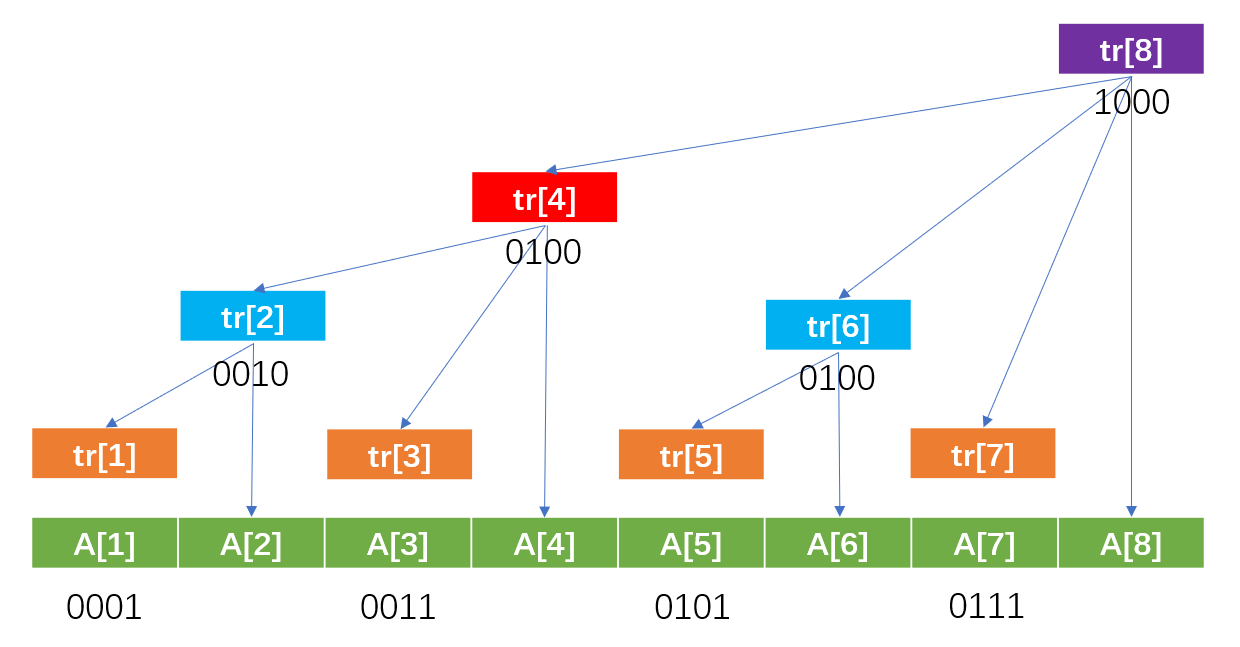为什么需要树状数组?
当我们需要维护一个数组的前缀和S[i]=A[1]+A[2]+……+A[i]时,如果修改了任意一个A[i],S[i]都会发生变化。在最坏情况下,会需要O(n)时间,引入树状数组后,修改和求和都是O(logn),极大提高效率。
基本思想:根据任意正整数关于2的不重复次幂唯一分解性质,若一个正整数21的二进制表示为10101 = + + ,因此,区间[1,x]可以分成O(logx)个小区间:
- 长度为的小区间[1, ],即[1,16];
- 长度为的小区间[ + 1, + ],即[17,20];
- 长度为的小区间[+ + 1, + + ],即[21,21]。
这些子区间共同特点是:若区间结尾为R,则区间长度就是R的二进制分解下最小的1所在位置2的次幂,设为lowbit(R)。
例如:
- 16=10000,区间长度16=;
- 20=10100,区间长度4=;
- 21=10101,区间长度1=。

- 1=(0001) tr[1]=A[1]
- 2=(0010) tr[2]=A[1]+A[2]
- 3=(0011) tr[3]=A[3]
- 4=(0100) tr[4]=A[1]+A[2]+A[3]+A[4]
- 5=(0101) tr[5]=A[5]
- 6=(0110) tr[6]=A[5]+A[6]
- 7=(0111) tr[7]=A[7]
- 8=(1000) tr[8]=A[1]+A[2]+A[3]+A[4]+A[5]+A[6]+A[7]+A[8]
tr[i]=A[i-+1]+A[i-+2]+……+A[i]
如何快速求出 i 的区间长度呢?这里我们要学习一个函数:lowbit(x)
int lowbit(int x) { return x & (-x); }
例如,x = 20,则 -x = -20,由于计算机中负数都是以补码的形式来存储,则有如下计算过程:

单点更新
例如:当前更改A[1],在A[1]基础之上加t
1=(0001) tr[1]+=t 1+lowbit(1)=2(0010)
2=(0010) tr[2]+=t 2+lowbit(2)=4(0100)
4=(0100) tr[4]+=t 4+lowbit(4)=8(1000)
8=(1000) tr[8]+= t 8+lowbit(8)=16(10000) 由于给定数组
长度是8,而16超过8,因此不需要继续计算。
void update(int x, int t){
while(x <= n){
tr[x] += t;
x += lowbit(x);
}
}
查询前缀和
假定x=7,sum[7]= A[1]+A[2]+A[3]+A[4]+A[5]+A[6]+A[7]
- tr[7]=A[7]
- tr[6]=A[5]+A[6]
- tr[4]=A[1]+A[2]+A[3]+A[4]
int sum(int x){
int res = 0;
while(x){
res += tr[x];
x -= lowbit(x);
}
return res;
}
编程实战
黑猫OJ B215. 树状数组模板-单点修改区间查询
参考程序
#include <iostream>
using namespace std;
const int N = 1e6 + 10;
int n, q;
int tr[N];
int lowbit(int x){
return x & -x;
}
void update(int x, int t){
while(x <= n){
tr[x] += t;
x += lowbit(x);
}
}
int sum(int x){
int res = 0;
while(x){
res += tr[x];
x -= lowbit(x);
}
return res;
}
int main(){
cin >> n >> q;
for(int i = 1; i <= n; i++) {
int t;
cin >> t;
update(i, t);
}
while(q--){
int flag;
cin >> flag;
if(flag){
int i, x;
cin >> i >> x;
update(i, x);
}
else{
int L, R;
cin >> L >> R;
cout << sum(R) - sum(L - 1) << endl;
}
}
return 0;
}
黑猫OJ #B214. 树状数组模板-区间修改单点查询
题目分析
利用差分思想。
参考程序
#include <iostream>
#include <cstdio>
#define lowbit(x) x&-x
using namespace std;
typedef long long LL;
const int N = 1e5 + 10;
int n, m;
LL tr[N];
void update(int x, int t){
while(x <= n){
tr[x] += t;
x += lowbit(x);
}
}
LL sum(int x){
LL res = 0;
while(x){
res += tr[x];
x -= lowbit(x);
}
return res;
}
int main() {
scanf("%d%d", &n, &m);
for(int i = 1; i <= n; i++){
int d;
scanf("%d", &d);
update(i, d), update(i + 1, -d);
}
while(m--){
char op[2];
int L, R, d, x;
scanf("%s", op);
if(*op == 'C'){
scanf("%d%d%d", &L, &R, &d);
update(L, d), update(R + 1, -d);
}
else{
scanf("%d", &x);
printf("%lld\n", sum(x));
}
}
return 0;
}
黑猫OJ #HM057. 区间修改区间查询
题目解析
a[1,x] 的前缀和: ...
而每个 都是我们维护的差分数组的前缀和: ... +
即 a[1,x] 的前缀和:
进一步展开:
...
...

... ...
参考程序
#include <iostream>
using namespace std;
typedef long long LL;
const int N = 100010;
int n, m;
int a[N];
LL d1[N]; // 维护 d[i] 的前缀和
LL d2[N]; // 维护 i*d[i] 的前缀和
int lowbit(int x) { return x & -x; }
void update(LL tr[], int x, LL k) {
while (x <= n)
{
tr[x] += k;
x += lowbit(x);
}
}
LL sum(LL tr[], int x) {
LL res = 0;
while (x)
{
res += tr[x];
x -= lowbit(x);
}
return res;
}
LL prefix_sum(int x) {
return sum(d1, x) * (x + 1) - sum(d2, x);
}
int main() {
scanf("%d%d", &n, &m);
for (int i = 1; i <= n; i++){
scanf("%d", &a[i]);
update(d1, i, a[i]); update(d1, i + 1, -a[i]);
update(d2, i, (LL)a[i] * i); update(d2, i + 1, - (LL)a[i] * (i + 1));
}
while (m--) {
int op, x, y, k;
scanf("%d%d%d", &op, &x, &y);
if (op == 1){
scanf("%d", &k);
// 区间修改
update(d1, x, k), update(d2, x, x * k);
update(d1, y + 1, -k), update(d2, y + 1, - (y + 1) * k);
}
else
printf("%lld\n", prefix_sum(y) - prefix_sum(x - 1));
}
return 0;
}
黑猫OJ #B217. 校门外的树【进阶】
题目分析
在一个区间 [i, j] 上种树,我们可以在 i 处放一个左括号,在 j 处放一个右括号,表示区间 [i, j] 种了树。
可以发现,查询某个区间树的种类个数时,如区间 [i, j],只要拿 j( 包括j )之前的左括号数量 减去 i( 不包括 i)之前的右括号数量即可。
故用两个树状数组分别维护左右括号的前缀和,更新时记录左右括号数,查询时相减即能得到结果。
参考程序
#include <iostream>
using namespace std;
const int N = 5e4 + 10;
int n, m;
int trl[N], trr[N];
int lowbit(int x){
return x & -x;
}
void update(int x, int t, int tr[]){
while(x <= n){
tr[x] += t;
x += lowbit(x);
}
}
int sum(int x, int tr[]){
int res = 0;
while(x){
res += tr[x];
x -= lowbit(x);
}
return res;
}
int main(){
cin >> n >> m;
while(m--){
int op, L, R;
cin >> op >> L >> R;
if(op == 1)
update(L, 1, trl), update(R, 1, trr);
else
cout << sum(R, trl) - sum(L - 1, trr) << endl;
}
return 0;
}